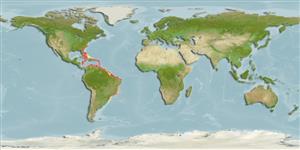Environment: milieu / climate zone / intervalo de profundidade / distribution range
Ecologia
marinhas associadas(os) a recifes; intervalo de profundidade 1 - 75 m. Subtropical; 37°N - 33°S, 82°W - 34°W
Western Atlantic: North Carolina, USA and Bermuda to Brazil.
Tamanho / Peso / Idade
Maturidade: Lm ? range ? - ? cm
Max length : 56.0 cm TL macho/indeterminado; (Ref. 26340); common length : 30.0 cm TL macho/indeterminado; (Ref. 3815); peso máx. Publicado: 680.00 g (Ref. 40637)
The cheek area is usually blue with yellow spots; the blue markings on the scales are more linear; no horizontal blue band above the gill opening, but a dark bluish smudge may often seen behind the upper end of the opening (Ref. 13442).
Body shape (shape guide): short and / or deep.
Adults are frequently found in coral areas, while the young prefer vegetated (e.g. Thalassia), sandy bottoms. Feeds mainly on mollusks, worms, brittle stars, hermit crabs, crabs and sea urchins. Easily approached (Ref. 9710). Marketed fresh and frozen (Ref. 5217).
Life cycle and mating behavior
Maturidade | Reprodução | Desova | Ovos | Fecundidade | Larvas
Robins, C.R. and G.C. Ray, 1986. A field guide to Atlantic coast fishes of North America. Houghton Mifflin Company, Boston, U.S.A. 354 p. (Ref. 7251)
Categoria na Lista Vermelha da IUCN (Ref. 130435: Version 2025-1)
Ameaça para o homem
Reports of ciguatera poisoning (Ref. 30911)
Utilização humana
Pescarias: pouco comercial; peixe desportivo: sim
Ferramentas
Relatórios especiais
Descarregue XML
Fontes da internet
Estimates based on models
Preferred temperature (Ref.
123201): 22.8 - 27.9, mean 26.7 °C (based on 222 cells).
Phylogenetic diversity index (Ref.
82804): PD
50 = 0.5001 [Uniqueness, from 0.5 = low to 2.0 = high].
Bayesian length-weight: a=0.02291 (0.01439 - 0.03647), b=2.93 (2.80 - 3.06), in cm total length, based on LWR estimates for this species & Genus-body shape (Ref.
93245).
Nível Trófico (Ref.
69278): 3.5 ±0.2 se; based on diet studies.
Resiliência (Ref.
120179): Baixo, tempo mínimo de duplicação da população 4,5 - 14 anos (Preliminary K or Fecundity.).
Fishing Vulnerability (Ref.
59153): Moderate vulnerability (42 of 100).
🛈
Nutrients (Ref.
124155): Calcium = 22.6 [9.6, 46.7] mg/100g; Iron = 0.517 [0.263, 1.088] mg/100g; Protein = 20 [19, 21] %; Omega3 = 0.167 [0.095, 0.304] g/100g; Selenium = 17.5 [7.7, 36.4] μg/100g; VitaminA = 29 [7, 124] μg/100g; Zinc = 0.63 [0.39, 0.96] mg/100g (wet weight);
